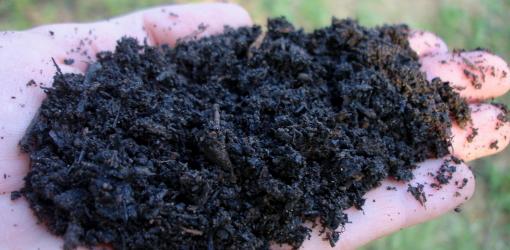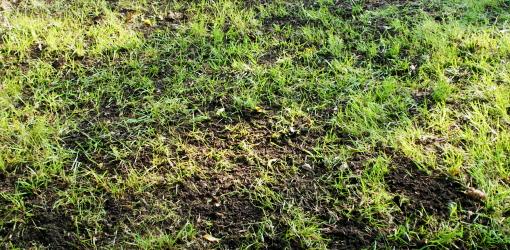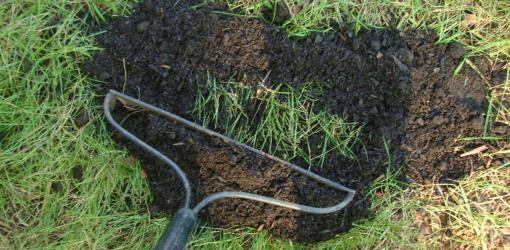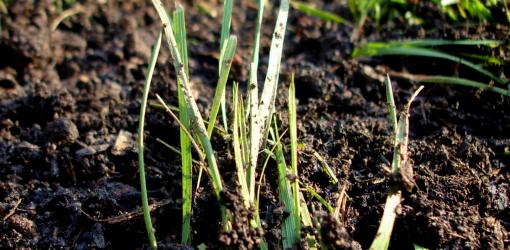I’m a super proponent of all things topdressing. The reason being is that it’s such a great practice when done so with compost. Even if one were to never fertilize their lawn, but regularly topdress it, you could still achieve tremendous results.
A nice, thick lawn requires healthy soil as its base, but it’s difficult to make changes to the soil once grass has been established. Most gardening recommendations include “working” organic matter into the soil through digging or tilling prior to planting, but this can’t be done once the grass has grown. So what’s a homeowner to do with an established lawn that’s in need of some serious help?
If done properly, the technique of “topdressing,” or adding a thin layer of soil over your lawn, can improve the soil without killing the existing turf. Topdressing addresses some common lawn problems, including:
- Low spots due to rotting tree roots, settling after underground pipe or cable installation, or erosion.
- Uneven terrain caused by winter freezing and thawing, water runoff, tunneling critters, or general soil settling over time.
- Compacted soil in high-traffic areas or low-lying places where water pools.
- Bare spots from variations in soil texture and nutrients, heat, drought, or other environmental damage.
- Depletion of nutrients due to leaching, neglect, or repeated use of chemical fertilizers.*
- It’s for this fact alone that I’ve become such a proponent of incorporating organics into my program. Synthetic, chemical fertilizers, over time, begin to rob the soil of life. It harms microbes and beneficial bacteria and ultimately you’re left with a tired, depleted growing medium.
Topdressing gradually improves soil over time. As organic matter breaks down, it filters through the existing soil to improve texture and overall health. Topdressing can:
- Improve drainage and drought-resistance
- Even out the terrain
- Reduce the need for supplemental fertilizers
- Transform your lawn into organic, low-maintenance, healthy turf
When to Topdress
Ideally, do it in early fall or spring since you’ll want to give your grass time to grow through 3-4 more mowings before severe heat or cold, especially if you are overseeding. It can be done all at once, or in stages. Here in Knoxville, we recommend topdressing in the fall; however, in certain instances, we prefer to topdress even before making a first application. Often times to establish a stand of turf, aerating, topdressing, and seeding is required to even begin lawn care program!
Topdressing involves some physical labor, but the process is really just a few simple steps:
Step 1: Aerate
Lawns should be aerated every years, and if yours is due, start with a nice core aeration. Core aeration removes plugs of soil from the ground and leaves channels for air, water, and our topdressing mixture to penetrate the surface. For more information, see our article on Aeration.
Step 2: Prepare Your Topdressing
At Outdoor Designs, we use a high quality, beneficial bacteria rich, organic compost.
Ultimately anything that incorporates sand, loamy soil, and maybe some peat will suffice, but in our experience, a high quality compost delivers greater results more consistently.
The compost we use is heat treated to eliminate any weed seeds.
Step 3: Apply Topdressing
Now we’re ready to get started.
We spread the compost working it into aeration holes and covering low spots. We make sure the top-dressing is no more than 1” deep (preferably ½” or less) over the existing grass.
We keep working the mixture until your grass peeks through and the depth is even. I like to flip the garden rake back and forth from the flat side to the tine side, carefully combing the grass to get the top-dressing mixture settled on the soil surface.
For low spots requiring more than a couple of inches of top-dressing, first remove the existing sod to prevent underground decay that can damage new grass seedlings. After filling in the low spot, either replace the old sod or re-seed the area. You can also address deeper spots by adding a couple of inches of top-dressing each year, slowly building it up over time.
Step 4: Water and Adjust
At this point we’re technically finished. I would recommend watering the area well (or topdressing before a nice rain), letting the mixture settle for a day or two.
Step 5: Plant Grass if Needed
Now we can replant grass in any bare spots. Existing grass should be able to grow through as much as an inch of top-dressing.
How Often to Topdress
Trouble spots may need repeat applications, but regular, uniform top-dressing does not need to be an annual tradition. Keep in mind that you’re adding soil, which over time will raise your grade and affect thatch breakdown and soil ecology, so don’t go overboard. Plan several light applications for troublesome yards, rather than one deep one. For overall organic soil amendment, a very light application of top-dressing brushed into aeration holes can improve the soil without raising the grade.



